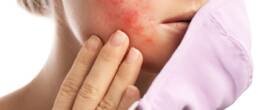Rosacea is a chronic skin condition that affects millions of people worldwide, causing redness, visible blood vessels, and, in some cases, small, red, pus-filled bumps. While it is not a life-threatening condition, rosacea can significantly impact self-confidence and quality of life. Fortunately, medical aesthetics offer several effective treatment options to manage its symptoms and improve skin appearance.
Rosacea is a long-term inflammatory skin disorder that primarily affects the face. It typically manifests as persistent redness, sensitivity, and sometimes swelling. The exact cause of rosacea is still unclear, but factors such as genetics, immune system response, gut dysbiosis, and environmental triggers are believed to contribute to the onset and flares in symptoms.
Rosacea presents in different forms, each with unique characteristics. Understanding the type of rosacea you have can help determine the best treatment approach.
Learn more about Rosacea and the different types by visiting the National Rosacea Society
The Four Types of Rosacea
1. Erythematotelangiectatic Rosacea (ETR) – Characterized by persistent facial redness, visible blood vessels (telangiectasia), and sensitivity. This type often includes episodes of flushing triggered by certain foods, beverages, or environmental conditions.
2. Papulopustular Rosacea – Often confused with acne, this type involves red bumps and pustules, usually on the cheeks, chin, and forehead. It is more common in middle-aged women and may be accompanied by burning or stinging sensations.
3. Phymatous Rosacea – This less common type leads to thickened, bumpy skin, especially on the nose (rhinophyma). It is more frequently seen in men and may result in enlarged oil glands and a rough texture.
4. Ocular Rosacea – Affecting the eyes, this type causes dryness, irritation, red eyelids, and sensitivity to light. It can be mistaken for conjunctivitis but does not resolve on its own without treatment.
Aesthetic Treatment Options for Rosacea
While there is no cure for rosacea, several medical aesthetic treatments can help reduce its appearance and control flare-ups.
1. Laser and Light Therapy
Intense Pulsed Light (IPL): Targets redness and visible blood vessels, improving skin tone and reducing flushing.
Vascular Laser Therapy: Specifically designed to shrink blood vessels, minimizing redness and broken capillaries.
Fractional Laser Treatments: Help improve skin texture, particularly for phymatous rosacea by reducing thickened areas.
Click here to learn more about Jett Plasma Therapy!
2. Chemical Peels
Mild chemical peels containing lactic acid or mandelic acid can help reduce inflammation and improve overall skin tone. These should only be performed by professionals experienced in treating sensitive skin conditions.
Click here to learn more about Chemical Peels!
3. Microneedling
Microneedling can enhance skin barrier function and improve overall texture, but it must be done carefully to avoid irritation. When combined with serums like hyaluronic acid, it can promote healing and reduce sensitivity.
Click here to learn more about Microneedling!
4. Medical-Grade Skincare
Using skincare products specifically designed for rosacea-prone skin can help maintain results from aesthetic treatments.
Look for:
- Niacinamide to calm redness
- Ceramides to strengthen the skin barrier
- Azelaic Acid to reduce inflammation and control breakouts
- Sunscreen (SPF 30+) to protect against UV triggers
Click here to learn more about Medical Grade Skincare!
5. Injectable Treatments
Botox (Botulinum Toxin): Emerging research suggests that microdoses of Botox may help control flushing and excessive redness.
Dermal Fillers: In some cases, fillers can improve the appearance of phymatous rosacea by smoothing out uneven skin texture.
In addition to medical aesthetic interventions, lifestyle changes can help minimize rosacea flare-ups. Avoiding known triggers such as spicy foods, dairy, alcohol, and extreme temperatures. Can help you keep flare ups at bay.
Ready to Calm the Redness?
Rosacea can be a frustrating condition, but with the right combination of lifestyle changes, medical aesthetic treatments, and medical grade skincare, symptoms can be effectively managed.
Are you considering aesthetic treatments for rosacea?
Schedule a consultation with a specialist to explore your options!
Ready for an expert opinion? Get in touch today!
At Skin Brava Aesthetics explore insights on regenerative skincare, holistic beauty, and cutting-edge treatments for radiant, healthy skin. Contact us today to schedule an appointment.
Like this article? Spread the word!
Related Posts
March 15, 2025
Rejuvenate Your Skin with Jett Plasma Skin Tightening: The Ultimate Solution for a Youthful Glow
Discover the benefits of Jett Plasma Skin Tightening at Skin Brava Aesthetics in Colorado…
May 15, 2025
Melanoma Awareness Month: Protect Your Skin and Know the Signs
Discover how to protect your skin during Melanoma Awareness Month with Skin Brava. Learn…
April 9, 2025
Reveal Luminous, Healthy Skin with Medical-Grade Facials at Skin Brava Aesthetics
Discover medical-grade facials at Skin Brava Aesthetics in Colorado Springs, CO. Hydrate,…





